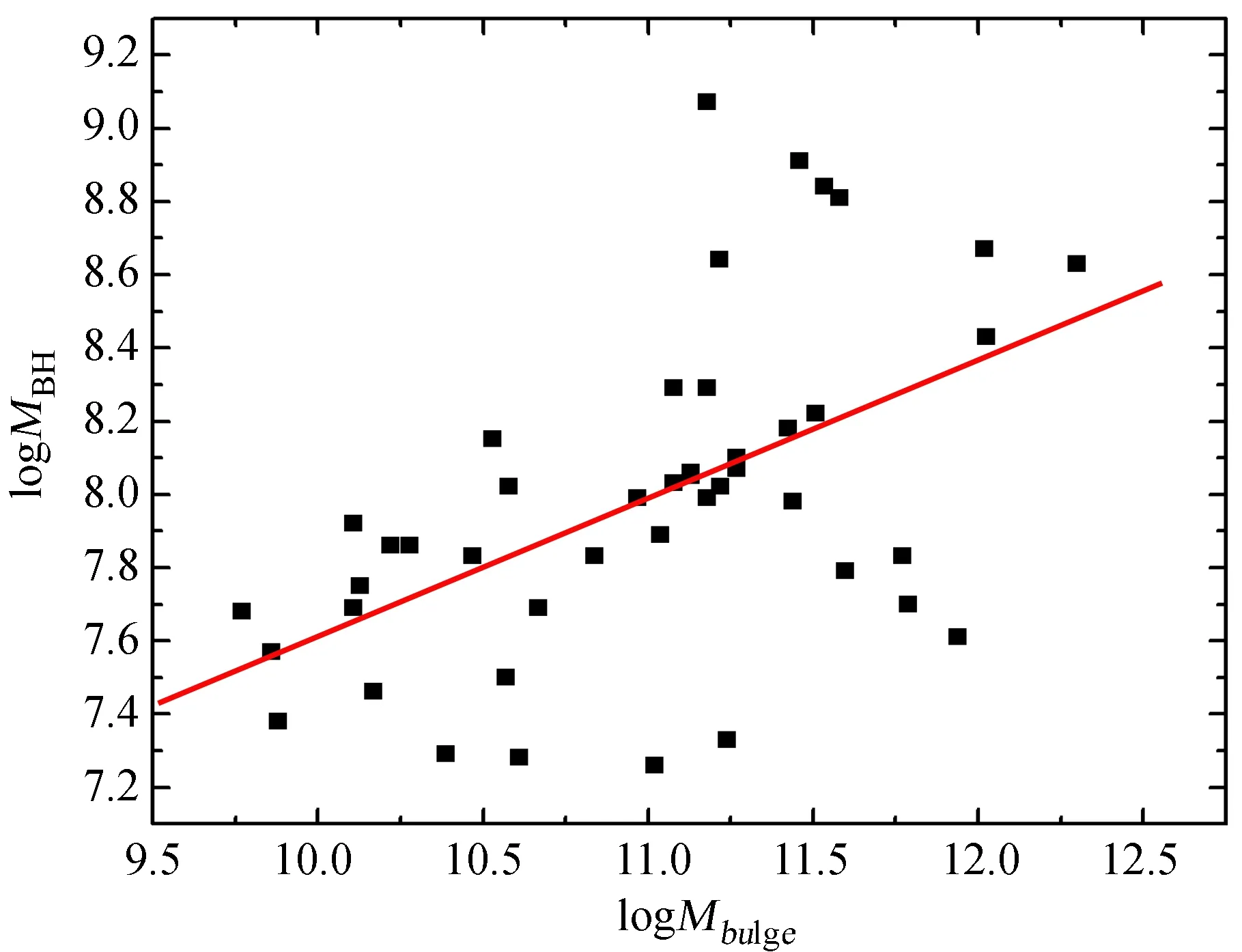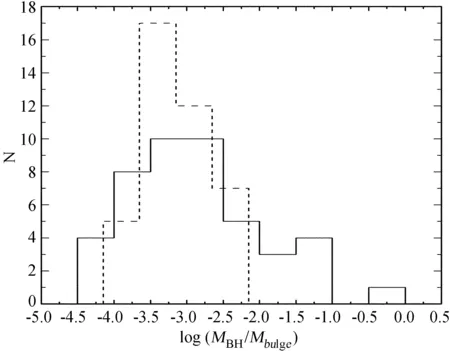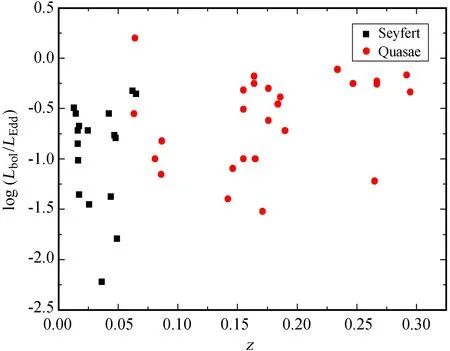活动星系核黑洞核球质量及宇宙学红移关系研究*
罗 丹,张皓晶,张 雄,丁 楠
(云南师范大学物理与电子信息学院,云南 昆明 650500)
活动星系核黑洞核球质量及宇宙学红移关系研究*
罗 丹,张皓晶,张 雄,丁 楠
(云南师范大学物理与电子信息学院,云南 昆明 650500)
通过文献收集了90个活动星系核样本,研究黑洞质量与核球质量的关系,分析黑洞质量及核球质量比与宇宙学红移的关系,进而研究活动星系核的演化关系,结果表明:(1)在Seyfert星系中黑洞质量与核球质量无明显相关,类星体中则呈线性相关;(2)活动星系核演化序列由类星体演化到Seyfert星系。
活动星系核;黑洞质量;核球质量;红移
活动星系核的演化实质上是天体在宇宙时标上的演化,而宇宙时标主要与宇宙学红移有关[1-2]。不同的天体有不同的宇宙学红移,因此可以利用宇宙学红移研究天体的演化[3]。Seyfert 星系与类星体作为活动星系核的两个子类,两者之间存在怎样的演化关系,文[4]和文[5]分别在1996年与1988年提出了从类星体到Seyfert星系的演化关系,现已有许多研究者从多方面对其进行了验证,如文[6]通过研究黑洞质量与红移的关系验证了从类星体到Seyfert 星系的演化。
现有的观测证据表明超大质量黑洞与其寄主星系的形成和演化密切相关(即黑洞质量与核球质量关系)[7-8]。黑洞质量与核球质量成比例的关系,但此种关系依照现有的研究来看有线性的,也有非线性的。本文在分析黑洞质量与核球质量之间关系的同时分析黑洞核球质量比与红移的关系,以此研究活动星系核的演化。
1 数据及分析
本文从文献中收集了45个Seyfert星系[7,9]和45个类星体[10-12]共90个样本的黑洞质量、核球质量、红移、热光度。利用热光度和黑洞质量计算得出热光度与爱丁顿光度比值。利用黑洞质量与核球质量算出其比值。90个样本见表1,表1中(1)样本名称;(2)样本类型(S为Seyfert 星系,Q为类星体);(3)红移值;(4)Hβ的FWHW值,以kms-1为单位;(5)热光度Lbol的对数值,以ergs-1为单位;(6)黑洞质量对数值,质量以M⊙为单位;(7)核球质量的对数值,质量以M⊙为单位;(8)黑洞质量与核球质量比的对数;(9)热光度与爱丁顿光度比值;(10)参考文献。
1.1 黑洞质量计算方法
1.1.1Mbh-σ*关系方法
文[13-15]提出黑洞质量和寄主星系之间大致存在比例关系,即使黑洞质量有~0.5%的散射。文[16-17]发现黑洞质量与σ*之间存在紧密的相关,其中σ*是黑洞引力作用之外恒星半径方向的视向速度弥散度,文[18]给出了黑洞质量与σ*的关系式:
MBH=(108.13M⊙)(σ*/200 kms-1)4.02,
(1)

表1 Seyfert星系与类星体样本

续 表
1.1.2 反响映射法(Reverberation Mapping)——Virial 黑洞质量
(2)
(3)
(2)式中,G表示引力常量;RBLR为宽线区半径;VBLR为宽线区气体的开普勒速率[19]。(3)式中,f表示几何因子;λLλ表示光度在相应波长处的光度与波长的乘积;FWHM表示Hβ的半峰全宽值;M⊙表示太阳质量[20]。
1.1.3MBH-Lbulge关系方法
log(MBH/M⊙)=-0.50MR-2.60,
(4)
(5)

核球V波段的绝对星等与R波段绝对星等存在关系V-R=0.8。本文采用黑洞质量皆由反响映射法计算得出。
1.2 核球质量计算方法
由正常星系质量-光度关系得到logMbulge[7]:
log(Mbulge/M⊙)=1.18log(Lbulge/L⊙)-1.11,
(6)

2 统计分析
2.1 黑洞质量与核球质量的关系
从图1中可以看出Seyfert 黑洞质量与核球质量之间没有明显的相关性,采用最小二乘法线性拟合为
logMbulge=(0.23±0.13)logMBH+(4.83±1.32),
(7)
其中相关系数为R=0.27;随机概率P=0.078。
从图2中可以看出类星体黑洞质量与核球质量之间呈线性相关的关系,采用最小二乘法线性拟合为
logMbulge=(0.38±0.09)logMBH+(3.83±1.01),
(8)
其中相关系数为R=0.53;随机概率P=0.0001。

图1 Seyfert星系黑洞与核球质量关系

图2 类星体黑洞与核球质量关系
图3为45个Seyfert 和45个类星体的黑洞核球质量比的分布直方图。
2.2 黑洞核球质量比与红移的关系
图4为黑洞核球质量比与红移z的关系图,从图中可以看出类星体主要分布在右部分,随着演化进行,红移逐渐减小,且红移量为表征天体演化年龄的重要因素,到红移量较低时,类星体过渡到Seyfert星系,从而可以得到类星体到Seyfert星系的演化。
图5为热光度与爱丁顿光度之比与红移z的关系图,图5为图4的参考,且因为本文相关文献中得到的可靠Lbol/LEdd数量较少,所以只有部分Seyfert星系和类星体有数值。从图中可以看出较高红移的类星体出现在早期,随着演化的进行,Lbol/LEdd值减小,当红移到达一定值时,Seyfert星系过渡到类星体。

图3 黑洞核球质量比的分布直方图(实线为Seyfert 星系,虚线为类星体)
Fig.3 Histograms of the ratios of the black-hole mass values to the bulge-mass values in the sampled Seyfert galaxies (in solid lines) and quasars (in dashed lines)

图4 黑洞核球质量与红移关系

图5 热光度与爱丁顿光度比与红移关系
3 结论和讨论
从以上的图像结果分析可得:(1)Seyfert星系黑洞质量与核球质量没有明显的相关性,而类星体黑洞质量与核球质量之间呈线性相关;(2)通过对黑洞核球质量比与红移关系的研究发现类星体与Seyfert星系之间的演化关系为类星体到Seyfert星系。
本文通过研究黑洞与核球质量比与红移z的关系模拟活动星系核的演化,得出了从类星体到Seyfert星系的演化序列,与文[3-4]用黑洞质量与红移以及吸积率、热光度与红移关系得出的演化关系基本一致。但样本是依据现有能找到的活动星系核的核球质量及其红移的大小选择的,从现有的活动星系核的核球质量得到样本这一点上来说存在一定的选择效应,但是对于本文预设的科学目标没有很大的影响,且本文在红移z在0.3~0.5范围内无有效数据,在今后的工作中将收集在这一红移段的相关数据,对活动星系核的演化作进一步的研究。在黑洞质量与核球质量关系中发现Seyfert星系黑洞质量与核球质量无明显的相关,说明黑洞对于外界物质的吸收不具规律,而类星体呈线性相关。鉴于此,是否可以说明相较于类星体,Seyfert星系更为活跃,抑或是由于样本容量较小,出现这样的结果。此外,不同类型的活动星系核具有不同的宇宙学红移,从现有的观测结果来看,类星体红移较高,Seyfert星系红移较低,但因为Seyfert星系的光度较小,可能存在高红移的Seyfert星系没有被观测到,或者已经演化;再者,Seyfert星系为漩涡星系,类星体为椭圆星系,当漩涡星系越旋越紧,最后将变成椭圆星系[12]。从以上两点来看活动星系核的演化序列也可能是Seyfert星系到类星体,具体应该是怎样的结果将在以后的工作中收集更多的证据加以证明。
[1] Best P N, Ker L M, Simpson C, et al. The comic evolution of radio-AGN feedback to z=1[J]. Monthly Notices of the Royal Astronomical Society, 2014, 445(1): 955-969.
[2] 熊定荣, 张雄, 郑永刚, 等. 射电类星体的演化与宇宙学红移[J]. 天文研究与技术——国家天文台刊, 2013, 10(2): 110-120. Xiong Dingrong, Zhang Xiong, Zheng Yonggang, et al. The evolution of radio quasars with cosmological redshift[J]. Astronomical Research & Technology——Publications of National Astronomical Observatories of China, 2013, 10(2): 110-120.
[3] 董霞, 张皓辉, 熊定荣, 等. 活动星系核中黑洞质量与宇宙学红移的研究[J]. 云南师范大学学报: 自然科学版, 2013, 33(1): 9-12. Dong Xia, Zhang Haohui, Xiong Dingrong, et al. The research about black hole mass and cosmological redshift in active galactic nuclei[J]. Journal of Yunnan Normal University: Natural Sciences Edition, 2013, 33(1): 9-12.
[4] Punsly B. Spectral diagnostics of blazar central engines. II. hydromagnetic theory[J]. The Astrophysical Journal, 1996, 473(1): 178-203.
[5] Park S J, Vishniac E T. The evolution of the central black hole in an active galactic nucleus, I-Evolution with a constant mass influx[J]. The Astrophysical Journal, 1988, 332 (1): 135-140.
[6] 尤莉莎, 张雄. 活动星系核的演化与宇宙学红移[J]. 天文研究与技术——国家天文台刊, 2007, 4(2): 108-l12. You Lisha, Zhang Xiong. Active galactic nuclei and the redshift[J]. Astronomical Research & Technology——Publications of National Astronomical Observatories of China, 2007, 4(2): 108-112.
[7] 巢梨花, 卞维豪, 黄克谅. 低红移活动星系核中大质量黑洞与核球质量关系研究[J]. 南京师大学报: 自然科学版, 2006, 29(3): 29-35. Chao Lihua, Bian Weihao, Huang Keliang. Mass relation between the black hole and the Bulge for low redshift AGNs[J]. The Journal of Nanjing Normal University: Natural Sciences Edition, 2006, 29(3): 29-35.
[8] Bao Yuying, Zhang Xiong, Chen Luoen, et al. Studies of the black hole mass and the Eddington rate of AGNs[J]. Acta Astronomica Sinica, 2008, 49(2): 123-132.
[9] Hao C N, Xia X Y, Mao S D, et al. The physical connections among IR QSOs, PG QSOs and narrow-line seyfert 1 galaxies[J]. The Astrophysical Journal, 2005, 625: 78-88.
[10]Sanghvi J, Kotilainen J K, Falomo R, et al. The black hole-host galaxy relation for very low mass quasars[J]. Monthly Notices of the Royal Astronomical Society, 2014, 445(2): 1261-1268.
[11]Kim M, Ho L C, Peng C Y, et al. The origin of the intrinsic scatter in the relation between black hole mass and bulge luminosity for nearby active galaxies[J]. The Astrophysical Journal, 2008, 687(2): 767-827.
[12]Wandel A. Black holes of active and quiescent galaxies: I. the black hole-bulge relation revisited[J]. The Astrophysical Journal, 2002, 565: 762-772.
[13]Shields G A, Menezes K L, Massart C A, et al. The black hole-bulge relationship for QSOs at high redshift[J]. The Astrophysical Journal, 2006, 641: 683-688.
[14]Gregory A S, Karl G, Salviander S, et al. The black hole-bulge relationship in quasars[J]. The Astrophysical Journal, 2004, 583: 124-133.
[15]Magorrian J, Tremaine S, Richstone D, et al. The demography of massive dark objects in galaxy centers[J]. The Astronomical Journal, 115(6): 2285-2305.
[16]Gebhardt K, Bender R, Bower G, et al. A relationship between nuclear black hole mass and galaxy velocity dispersion[J]. The Astrophysical Journal, 2000, 539(1): L13-L16.
[17]Ferrarese L, Merritt D. A fundamental relation between supermassive black holes and their host galaxies[J]. The Astrophysical Journal, 2000, 539(1): L9-L12.
[18]Tremaine S, Gebhardt K, Bender R, et al. The slope of the black hole mass versus velocity dispersion correlation[J]. The Astrophysical Journal, 2002, 574(2): 740-753.
[19]McLure R J, Jarvis M J. Measuring the black hole masses of high redshift quasars[J]. Monthly Notices of the Royal Astronomical Society, 2002, 337(1): 109-116.
[20]Labita M, Treves A, Falomo R, et al. The BH mass of nearby QSOs: a comparison of the bulge luminosity and viral methods[J]. Monthly Notices of the Royal Astronomical Society, 2006, 373(2): 551-560.
[21]刘学富. 基础天文学[M]. 北京: 高等教育出版社, 2004.
A Study of Relations of Black-Hole Mass Values and Bulge-Mass Values to Redshifts of AGN
Luo Dan, Zhang Haojing, Zhang Xiong, Ding Nan
(College of Physics and Electronics, Yunnan Normal University, Kunming 650500, China, Email: kmzhanghj@163.com)
In this paper we present a study of relations of black-hole mass values and bulge-mass values to redshifts of 90 AGN in Seyfert galaxies and quasars collected by us from various
. Our study covers the subject of evolution of ratios of the black-hole mass values to the bulge-mass values. Our results are as follows. (1) There is a linear correlation below black-hole mass values and bulge-mass values in quasars, but there is no clear correlation between such ratios and redshifts for Seyfert galaxies. (2) Our results support the notion that the evolution of AGN is in the sequence of from quasars to Seyfert galaxies.
AGN; Black-hole mass; Bulge mass; Redshift
国家自然科学基金 (11163007);国家自然科学基金 (U1231203); 云南省自然科学基金 (2012FB140)资助.
2015-03-05;修定日期:2015-05-06
罗 丹,女,硕士. 研究方向:天体物理. Email: 909391639@qq com
张皓晶,男,副教授. 研究方向:天体物理. Email: kmzhanghj@163 com
P157.7
A
1672-7673(2015)04-0403-07
CN 53-1189/P ISSN 1672-7673

